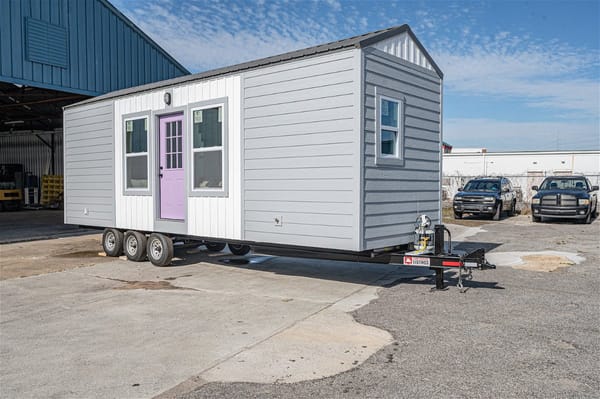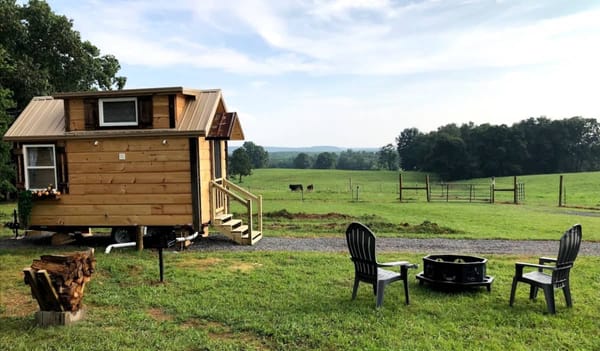Owning a tiny house and investing the savings
The modern tiny house movement really was a knee-jerk reaction to the conspicuous consumption pattern of American life in the 1980s. Turns out “greed is good” may not have been so good. A countercultural rise of environmentalism and social consciousness inspired people to downsize, declutter, and live more simply. Mixed the wildly popular open floor concepts of apartments on the West Coast and factory lofts in the Northeast region, small spaces and what we now call tiny houses, started taking shape as a way to escape the noise of the consumer culture. After the real estate market and its swinging arm loans and over-extended mortgages imploded in 2007, the modern tiny house movement gained major traction as it became a way for people to keep a roof over their head without going into debt against an income they just weren’t earning any longer. “Right-sizing” became a thing and homeowners were desperately searching for a way to get more bang for their buck. Do-it-yourself builders and professional builders were off to the races and tiny houses became popular homes, second homes, vacation homes, and even investments.
Because a tiny house averages just 300 square feet a homeowner can get a lot more for their money allowing them to save more money than ever and have a disposable income that just didn’t exist before. It was nothing to read an article or watch a YouTube video after 2010 where tiny house owners spoke of spending just $11 on their monthly electrical bill! But what does one do with this newfound savings? How can owning a tiny house turn into investment security? Perhaps these four tips will get you started on your own tiny house real estate portfolio.
BUILD FOR YOURSELF
Tiny housing is an appealing alternative for minimalists and those looking to invest in life and experience rather than just a structure. With a DIY building cost ranging from $12,000 to $45,000, tiny homes are affordable and highly customizable to suit your needs and your personality. The financial freedom compared to buying a home could be huge. By building “cash on the barrel” or taking your time in order to pay for everything with cash, building for yourself allows you to save on inflated labor costs and large up-front payments.
BUILD AND RENT AS RECREATION PROPERTY
Before you go building a tiny house and sticking it in your driveway, this option does take a little more homework. Yes, building a tiny house to have as a ‘man cave’ or a guest bedroom or anything like it, is an awesome way to capitalize on the investment. However, not all municipalities allow for ADUs (or Accessory Dwelling Units). You need to make sure you can have a space built outside the confines of your single-family dwelling. If you are instead, building a weekend cabin for yourself on some mountain property you own, you just need to check on building permits required, water and infrastructure requirements and options, and even access to the house.
INVEST IN A MONTHLY OR SHORT TERM RENTAL
When you’re looking for a real estate investment with less intensive day-to-day involvement, monthly rentals can have a nice return depending on where it’s located. If you are intending to offer your tiny house on a site like Airbnb or Vrbo you’ll need to make arrangements for more consistent management (sometimes daily!). However, a tiny house available for rent can be a great way to make a regular (albeit passive) income. Consider using a travel trailer permanently parked at a campground or RV resort. Think about a yurt in a beautiful open prairie. The options here are limitless but are sure to offer a good return on a small investment.
FLIP TINY HOMES
A tiny home investment flip is like a more traditional house flip. You build a tiny house, sell it on a site like Tiny House Listings, and make a tidy profit. When you flip a tiny house your stakes are lower, your investment is lower, and your risk is lower. It is a tried and true method when you keep overhead down, you track and maintain your time, and you sell at a reasonable price yet allowing for a reasonable profit margin.
Tiny home investments can be quite lucrative. They do, however, require you to do your homework, research your land restrictions, and get to know the modern tiny house community, with the end goal being to make money and have fun doing so. New and creative ways to grow wealth are constantly flowing from the tiny home movement including buying a tiny house from Tiny House Listings, enhancing it, and reselling it quickly. Now is the time to strike though as tiny house sales are increasing daily. Don’t let the opportunity pass you by!



